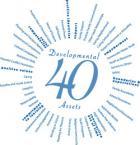| Notice them. |
Smile a lot. |
Acknowledge them. |
| Ask them about themselves. |
Look in their eyes when you talk to them. |
Remember their birthdays. |
| Play with them. |
Learn their names. |
Listen to them. |
| Read aloud together. |
Seek them out. |
Giggle together. |
| Be nice. |
Say yes a lot. |
Be honest. |
| Tell them their feelings are okay. |
Set boundaries that keep them safe. |
Feed them when they're hungry. |
| Be yourself. |
Listen to their stories. |
Hug them. |
| Notice when their acting differently. |
Present options when they seek your counsel. |
Stay with them when they are afraid. |
| Play outside together. |
Surprise them. |
Share their excitement. |
| Suggest better behaviors when they act out. |
Delight in their discoveries. |
Forget your worries sometimes and concentrate only on them. |
| Follow them when they lead. |
Send them a letter or postcard. |
Invite them over for juice. |
| Notice when they're absent. |
Call them to say hello. |
Hide surprises for them to find. |
| Give them space when they need it. |
Contribute to their collections. |
Discuss their dreams and nightmares. |
| Laugh at their jokes. |
Be relaxed. |
Kneel, squat, or sit so you're at thier level. |
| Answer their questions. |
Tell them how terrific they are. |
Create a tradition with them and keep it. |
| Learn what they have to teach. |
Use your ears more than your mouth. |
Make yourself more available. |
| Show up to concerts, games,and events. |
Find a common interest. |
Hold hands during a walk. |
| Apologize when you've done something wrong. |
Listen to their favorite music with them. |
Keep the promises you make. |
| Wave and smile when you part. |
Display their artwork in your home. |
Thank them. |
| Point out what you like about them. |
Clip magazine pictures or articles that interest them. |
Give them lots of compliments. |
| Catch them doing something right. |
Encourage win-win situations. |
Give them your undivided attention. |
| Ask for their opinion. |
Have fun together. |
Be curious with them. |
| Introduce them to your friends and families. |
Tell them how much you like being with them. |
Let them solve most of their own problems. |
| Meet their friends. |
Meet their parents. |
Let them tell you how they feel. |
| Help them become an expert at something. |
Be excited when you see them. |
Tell them about yourself. |
| Let them act their age. |
Praise more; criticize less. |
Be consistent. |
| Admit when you make a mistake. |
Enjoy your time together. |
Give them a special nickname. |
| Marvel at what they can do. |
Tell them how proud you are of them. |
Pamper them. |
| Unwind together. |
Be happy. |
Ask them to help you. |
| Support them. |
Applaud their successes. |
Deal with problems and conflicts while they're still small. |
| Chaperone a dance. |
Tell them stories in which they are the hero. |
Believe in them. |
| Nurture them with good food, words and fun. |
Be flexible. |
Delight in their uniqueness. |
| Let them make mistakes. |
Notice when they grow. |
Wave and honk when you drive by them. |
| Give immediate feedback. |
Include then in conversations. |
Respect them. |
| Join in their adventure. |
Visit their schools. |
Help them learn something new. |
| Be understanding when they have a difficult day. |
Give them good choices. |
Respect the choices they make. |
| Be silly together. |
Hang out together. |
Make time to be with them. |
| Inspire their creativity. |
Accept them as they are. |
Become their advocate. |
| Appreciate their individuality. |
Talk openly with them. |
Tolerate their interruptions. |
| Trust them. |
Share a secret. |
Write a chalk message on their sidewalk. |
| Create a safe, open enviroment. |
Be available. |
Cheer their accomplishments. |
| Encourage them to help others. |
Tackle new tasks together. |
Believe what they say. |
| Help them take a stand and stand with them. |
Daydream with them. |
Do what they like to do. |
| Make decisions together. |
Magnify their magnificence. |
Build something together. |
| Encourage them to think big. |
Celebrate their firsts, lasts, such as the first day of school. |
Go places together. |
| Welcome their suggestions. |
Visit them when they're sick. |
Tape record a message for them. |
| Help them learn from mistakes. |
Be sincere. |
Introduce them to new experiences. |
| Share a meal together. |
Talk directly together. |
Be spontaneous. |
| Expect their best; don't expect perfection. |
Enpower them to help and be themselves. |
Love them, no matter what. |
|
|
|
